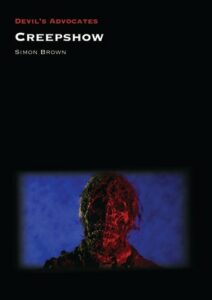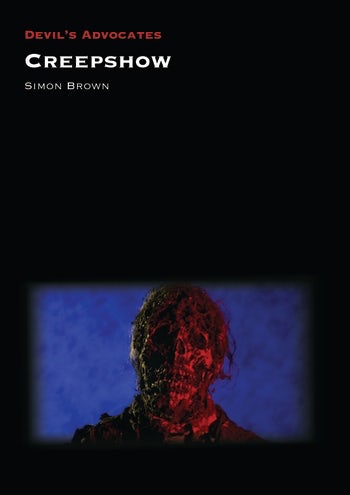CREEPSHOW (DEVIL’S ADVOCATES) by Simon Brown
 CREEPSHOW, the lightest, most purely fun of all Romero movies, doesn’t necessarily warrant a full academic analysis in the way that his lauded contributions to zombie cinema invite or, indeed, his fabulous revisionist Gothic MARTIN. Simon Brown, author of this entry in the Devil’s Advocates series of horror film monographs, does a fine job of placing the historic Romero-King collaboration in a wider context and acknowledges the film’s more throwaway nature by highlighting the “extra textual pleasures afforded by Ed Harris boogieing on down”.
CREEPSHOW, the lightest, most purely fun of all Romero movies, doesn’t necessarily warrant a full academic analysis in the way that his lauded contributions to zombie cinema invite or, indeed, his fabulous revisionist Gothic MARTIN. Simon Brown, author of this entry in the Devil’s Advocates series of horror film monographs, does a fine job of placing the historic Romero-King collaboration in a wider context and acknowledges the film’s more throwaway nature by highlighting the “extra textual pleasures afforded by Ed Harris boogieing on down”.
Ultimately the only direct cinematic union of the two horror legends, CREEPSHOW is here positioned in the cycle of more prestigious and serious King adaptations of the period and also with the overriding sense of his full-length novels garnering more respect than his short stories. The book documents CREEPSHOW’s origins as a failed NIGHT GALLERY-style King-fronted anthology series and its place as a stop-gap while King and Romero tried to get the long-mooted THE STAND adaptation off the ground. The importance of Milton Subotsky is acknowledged, the producer who first directly appropriated the stories and themes of the original EC Comics for cinema, albeit largely avoiding the comics’ gaudy visual style.
There are interesting insights into the production: some of the profanity and graphic violence from the original script were toned down, though the most famous money shot involving cockroaches (a memorable “Fangoria” cover image) was, curiously, not part of the original conception. A commercial hit, Brown suggests the film’s positive critical notices were the result of a more old-fashioned ambience than the slasher films that had been reviled so much by embarassingly misguided reviewers like Siskel and Ebert. CREEPSHOW is seen as arriving after a minor “horror comedy boom”, though this only really holds water if you consider AN AMERICAN WEREWOLF IN LONDON and THE HOWLING as horror-comedies rather than horror films with a keen sense of humour.
The strongest aspect of Brown’s analysis is the concise, affectionate guide to the evolution of EC Comics, reminding us of how their more gruesome tales of poetic justice sported a gore / cruelty quotient much stronger than the relatively subdued content of CREEPSHOW (a rare 15-rated modern horror film in “Video Nasties”-era Britain). We get a pleasant breeze through the ways in which the comics revelled in misanthropic, sick jokes within stories about a corrupt adult world that appealed to kids – until Frederick Wertham spoiled all the fun. Brown traces the EC influence on the careers of Romero, King and Tobe Hooper, while capturing the striking comic book stylisation of the film: the ambitious use of colour gels, thought balloons, split screens, animated transitions, captions, etc remain impressive and ahead of their time.
Other significant elements covered by the book are the film’s natural extension (via Jordy Verill) of both King and Romero’s identification with blue collar protagonists, and CREEPSHOW’s arrival at a crucial stage for gore and practical make-up effects in American horror films. There are questionable beats along the way: Cronenberg is singled out for the lack of humour in his work (on the contrary, his genre films are resplendent with black comedy and biting satire) and Brown seems to miss the point of the unfairly maligned MAXIMUM OVERDRIVE by lamenting the “staggeringly tasteless” Little Leaguer death scene. Nonetheless, CREEPSHOW’s many fans should find plenty of interest in this easily digested guide to its origins, creation and legacy.
Review by Steven West
CREEPSHOW is available now on KINDLE and PAPERBACK

